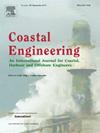浅水对岩甲稳定性的影响
IF 4.2
2区 工程技术
Q1 ENGINEERING, CIVIL
引用次数: 0
摘要
岩石甲层的水力稳定性在文献中得到了广泛的讨论,并提出了许多用于设计目的的公式。然而,有限的注意已经给予装甲稳定性在浅水条件下,很大程度上由于缺乏实验数据。本研究旨在通过提供浅水碎石丘防波堤岩甲壳层稳定性的新见解来解决这一空白。研究确定了四种不同结构坡度和不同水动力条件下的水力稳定性,从深水到极浅水,存在1V:30H的前滩。将新的实验数据与现有浅水有效的稳定性公式进行了比较,特别是van Gent等人(2003,VG)、Eldrup和Andersen (2019, EA)和Etemad-Shahidi等人(2020,ES)的稳定性公式。最初,这些数据被用来评估原始公式的准确性。在此之后,公式被重新校准,以考虑浅水的影响,数据根据水位分组。最后,为拟合实验数据,提出了修正版的VG和ES公式,并考虑了波浪陡度的影响,以更好地捕捉浅水动力学。本文章由计算机程序翻译,如有差异,请以英文原文为准。
The influence of shallow water on rock armour stability
The hydraulic stability of rock armour layers has been extensively discussed in the literature, with numerous formulae proposed for design purposes. However, limited attention has been given to armour stability under shallow water conditions, largely due to the scarcity of experimental data. This research aims to address this gap by providing new insights into the stability of rock armour layers with rubble mound breakwaters in shallow water. Hydraulic stability was determined for four different structure slopes and various hydrodynamic conditions, spanning from deep to extremely shallow water in presence of a 1V:30H foreshore. Newly experimental data were compared with existing stability formulae valid in shallow water, specifically those by van Gent et al. (2003, VG), Eldrup and Andersen (2019, EA), and Etemad-Shahidi et al. (2020, ES). Initially, the data were used to evaluate the accuracy of the original formulae. Following this, the formulae were recalibrated to account for the influence of shallow water, with data grouped according to water levels. Finally, modified versions of VG and ES formulae were developed to fit the experimental data, incorporating the effects of wave steepness to better capture shallow water dynamics.
求助全文
通过发布文献求助,成功后即可免费获取论文全文。
去求助
来源期刊

Coastal Engineering
工程技术-工程:大洋
CiteScore
9.20
自引率
13.60%
发文量
0
审稿时长
3.5 months
期刊介绍:
Coastal Engineering is an international medium for coastal engineers and scientists. Combining practical applications with modern technological and scientific approaches, such as mathematical and numerical modelling, laboratory and field observations and experiments, it publishes fundamental studies as well as case studies on the following aspects of coastal, harbour and offshore engineering: waves, currents and sediment transport; coastal, estuarine and offshore morphology; technical and functional design of coastal and harbour structures; morphological and environmental impact of coastal, harbour and offshore structures.
 求助内容:
求助内容: 应助结果提醒方式:
应助结果提醒方式:


